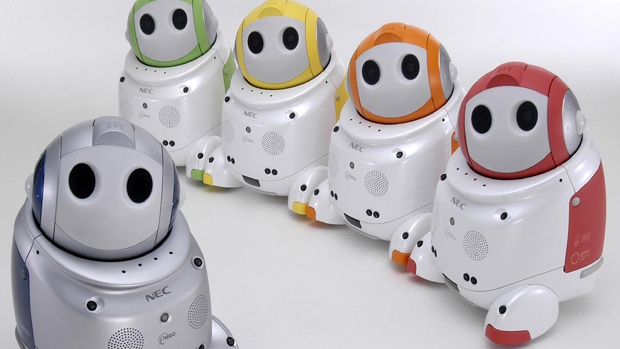NANAIMO (CUP) – Humans are social creatures, which means the greatest hurdle in truly intuitive communication with machines is their inability to generate and interpret social cues. Non-verbal communication like the position of our arms, where we look and how we speak are all social cues that, at this point, machines are incapable of recognizing.
Meet PaPeRo
Meet PaPeRo. He is about 15 inches tall and weighs almost 15 pounds, responds to his owners’ commands, recognizes their faces and even follows them around the house. PaPeRo is not a dog or cat – he’s a small robot.
PaPeRo (Partner-type-Personal-Robot)’s creators, NEC Mobile World, say, “Throughout the research and development we have always been cognizant of such questions as, ‘What is a robot?’ ‘What are robots to people?’ ‘What is the relationship between people and robots?’ and ‘What is life and society with robots?’” With these questions in mind, they developed PaPeRo, who has become the unofficial face of a budding new area of robotics research: social robotics.
Social robotics is the study of how robots can live with humans and help with their day-to-day lives. PaPeRo is still in development, but he can already respond to questions using simple sentences, remember things that people have said and sing songs. He can even learn and follow visual body language cues like responding in a peppy manner if he sees that his owner is happy. His objective isn’t to help with heavy lifting or rapid calculations, but simply to provide companionship and entertainment for his owners. This is the ultimate goal of social robotics.
Although social robotics is fairly young, it is no less interesting or important than other, more publicly displayed areas of artificial intelligence development. Computers and the Internet changed humanity’s lives for the better, and now, with these robots, NEC is looking to take the next step. With further development, instead of hit and miss Google searches, we will be able to verbally ask our computers a question and receive the results we want with a far greater degree of accuracy and intuition.
In a test involving several people who wanted to lose weight, three progress-tracking methods were used: pen and paper, a computer program and that same computer program running through a robotic head which smiled at progress and admonished the testers if they did not meet their fitness goals. Test subjects rated the computer twice as pleasant to use over pen and paper and the robot twice as pleasant as the computer, even though the program and questions were exactly the same. Participants even went so far as to name the robotic bust, and some were even sad to see it go, hugging and saying goodbye at the end of the test even though it was no longer plugged in or responding. This result cements the very essence of social robotics: create a machine that will be able to help people in ways never before possible, and relate to those people on a very nearly human scale simply by removing the screen and replacing it with a face.
One of the program’s creators, Cory Kidd, says the weight loss robot (dubbed “Autom“) “Has a short conversation with you every day to help you keep track of your eating and exercise quickly and simply. She provides feedback, advice, and encouragement to keep you motivated. She doesn’t scold – she offers positive encouragement to help you reach your goals.”
Tools to help
The ongoing rise of social robotics is a critical field of study, one that will ensure that we can move into the future aided by, rather than destroyed by, our mechanical counterparts. Once it is understood how robots can interact with humans on an instinctual level, we will be able to create tools to help people from any walk of life with any type of task. Teaching a robot to understand how we feel will not only allow them to interact with us in startling new ways, but it will also allow us to work with them in ways never before realized.
Teaching machines to understand what we feel is not the only change that is underway. Allowing machines to express how they feel to us is another critical step towards a future of friendly plastic pals.
Social robotics does not aim to take away the jobs of hardworking humans, but simply to make their lives easier, and, ultimately, to create a world where no one has to work at all because robots are capable of completing any type of task.
By Daniel O’Brien
The Navigator
Vancouver Island University





